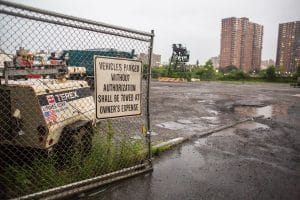Village Voice: City Hall says expansion of Bronx green space was never a formal commitment
by Patrick Arden September 5, 2017
“Antonetty and her neighbors still pine for the old parks along Jerome Avenue, which had been the centerpiece of their community. Macombs Dam Park was established in 1897, a quarter-century before the Yankees arrived in the Bronx, and the neighborhood grew up around it. Macombs Dam and Mullaly parks were worn from heavy use — one field was bare, and the grass could often be brown — but they had hundreds of mature leafy green trees, some sixty feet tall. The outdoor space held special importance for families crammed into one-bedroom apartments.
All that was lost in August 2006, when the city closed off the parkland to make way for a new stadium. State law requires the formal “alienation” of parks by the legislature before they can be used for non-park purposes. When Albany lawmakers alienated portions of Macombs Dam and Mullaly parks in 2005, Mayor Michael Bloomberg vowed to replace the green space with a new park on the old stadium site across the street, and with the addition of a set of other parcels elsewhere in the neighborhood.
Locals had problems with the “replacement” parks from the start. In exchange for a unified stretch of parkland, they would get plots of land scattered across more than a mile, with much less greenery and fewer ballfields. One of the largest replacements would sit two stories above street level atop a parking garage, with artificial surfaces and no trees. Small “pocket” parks would be in the shadow of the 4 train’s elevated tracks. A 2.89-acre asphalt ballfield wasn’t even replaced — the city converted it intoanother garage, insisting the land had only been used for parking cars, though project documents acknowledged it had been parkland.”
Yet Adrian Benepe, the city’s parks commissioner from 2002 to 2012, tells the Voice that all of what’s currently built of Mill Pond Park — including Pier 4 and the developed slice of Pier 5 — ended up as part of Yankee Stadium’s replacement parkland. The undeveloped section of Pier 5 wasn’t in that deal, Benepe says, though “it had been envisioned that it might be nice to have a park there one day.”
A little more history:
And from March 2006 Gotham Gazette:
“What if the city decided to put a stadium in the middle of your local park?
…instead of being set inside a large, green space surrounded by hundreds of mature trees, the fields would be scattered on separate parcels, including the tops of parking garages. The new recreational spaces would be closer to the highway and train tracks and an additional five-minute to half-hour walk from where people live. Most of the trees would be cut down. The new stadium would go smack in the middle of the community’s current park, next to a residential area.”
NYTimes 2008: “None of the replacement parks have been completed, and construction on several has not yet started; however, the parks department has built a temporary replacement park on a parking lot in the area, opened a ball field this spring at a school almost a mile to the east, and is building a sports field at a recreation center about a mile to the north.”
…Mr. Benepe [former NYC Parks Commissioner] said he was sympathetic to All Hallows High School and others …[re].. old Macombs Dam Park… “By the time all of the construction is done, this neighborhood will have one of the finest collection of parks and sports facilities anywhere in the city…”
From Bill Moyers (Updated September 12, 2013):
“There, in the South Bronx, the poorest district in the entire country, taxpayers were being asked to subsidize the private profits of one of the wealthiest franchises in organized sports. The Yankees’ owner at the time, the late George Steinbrenner, had bought the team for $10 million dollars in 1973, and by the time the old Yankee Stadium — “the House that Ruth built” — was ready to be replaced, it was worth $1.3 billion, according to Forbes.
Taxpayers were promised big bang for their buck, with new jobs and prosperity coming to a neighborhood feeling the full impact of the recession. The claim was considered dubious at the time, and a study conducted in 2011 found that the 3,400 stadium jobs paid a median wage of $10.50 an hour for non-managerial positions. The Yankees, meanwhile, had grabbed $50 million in tax breaks, $326 million in capital improvements, $1.2 billion in tax-exempt bonds and 24 acres of parks that had been owned by the public (after dragging its feet for several years, outrage over the loss of the parks eventually led the city to complete a long-promised facility for local youths last year).”


